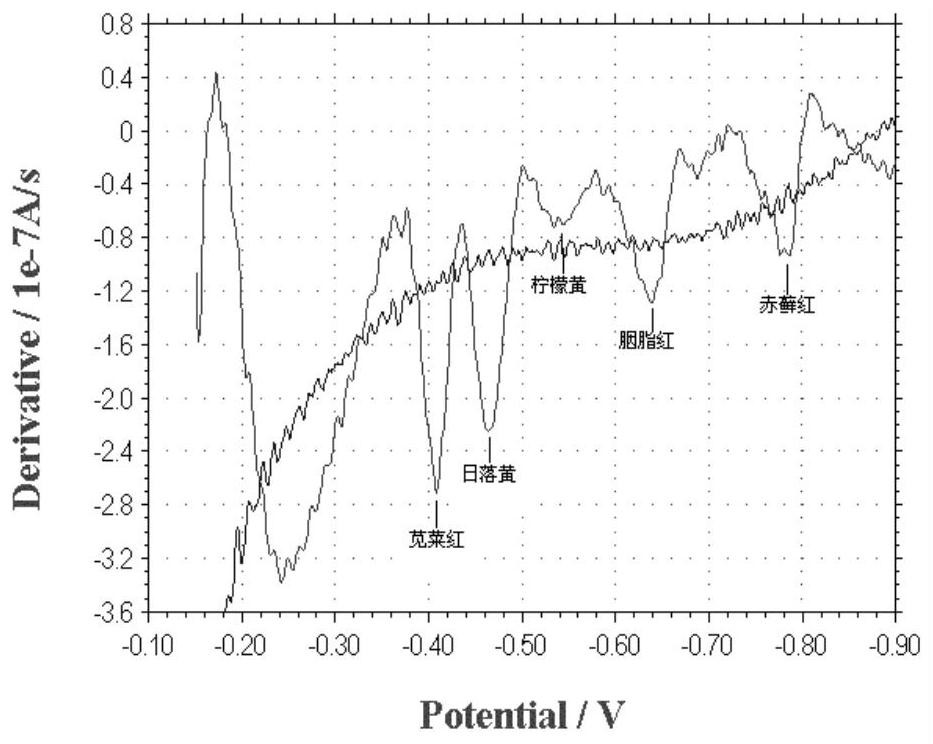Method for detecting artificially synthesized pigment by derivative voltammetry
A technology of artificial synthesis of pigments and voltammetry, applied in the direction of electrochemical variables of materials, etc., to achieve the effect of low detection limit, good anti-interference performance and low cost
- Summary
- Abstract
- Description
- Claims
- Application Information
AI Technical Summary
Problems solved by technology
Method used
Image
Examples
Embodiment 1
[0039] Detection of synthetic pigments by derivative voltammetry:
[0040] A three-electrode system was used, with a suspended mercury electrode as the working electrode, an Ag / AgCl electrode as the reference electrode, and a platinum wire electrode as the counter electrode. The mixed pigments were qualitatively and quantitatively analyzed by linear scanning differential voltammetry for 1.5 times. Specifically using 0.10mol / L of Na 2 HPO 4 -KH 2 PO 4 The buffer solution is an electrolyte solution, its pH is 6.6, the enrichment potential is set at -0.15V, the static time is 120 seconds, and the scanning speed is 0.05V / s.
Embodiment 2
[0042] Detection of synthetic pigments by derivative voltammetry:
[0043] A three-electrode system was used, with a suspended mercury electrode as the working electrode, an Ag / AgCl electrode as the reference electrode, and a platinum wire electrode as the counter electrode. The mixed pigments were qualitatively and quantitatively analyzed by linear scanning differential voltammetry for 1.5 times. Specifically using 0.15mol / L of Na 2 HPO 4 -KH 2 PO 4 The buffer solution is an electrolyte solution, its pH is 6.6, the enrichment potential is set at -0.15V, the static time is 120 seconds, and the scanning speed is 0.05V / s.
Embodiment 3
[0045] Detection of synthetic pigments by derivative voltammetry:
[0046] A three-electrode system was used, with a suspended mercury electrode as the working electrode, an Ag / AgCl electrode as the reference electrode, and a platinum wire electrode as the counter electrode. The mixed pigments were qualitatively and quantitatively analyzed by linear scanning differential voltammetry for 1.5 times. Specifically using 0.10mol / L of Na 2 HPO 4 -KH 2 PO 4 The buffer solution is an electrolyte solution, its pH is 7.4, the enrichment potential is set to -0.15V, the static time is 120 seconds, and the scanning speed is 0.05V / s .
PUM
 Login to View More
Login to View More Abstract
Description
Claims
Application Information
 Login to View More
Login to View More - R&D
- Intellectual Property
- Life Sciences
- Materials
- Tech Scout
- Unparalleled Data Quality
- Higher Quality Content
- 60% Fewer Hallucinations
Browse by: Latest US Patents, China's latest patents, Technical Efficacy Thesaurus, Application Domain, Technology Topic, Popular Technical Reports.
© 2025 PatSnap. All rights reserved.Legal|Privacy policy|Modern Slavery Act Transparency Statement|Sitemap|About US| Contact US: help@patsnap.com



